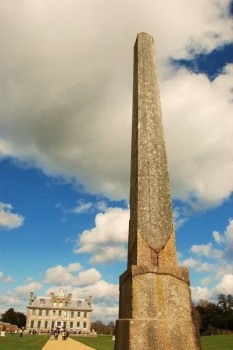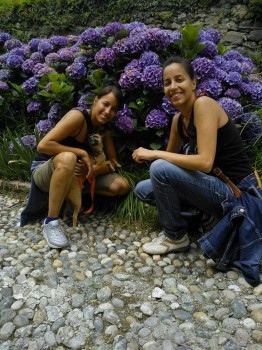As the contest to name the landing site on comet 67P/C-G draws to a close, we took another trip into the mission’s past, this time chasing the origin of Philae’s name. While the name of Rosetta was conceived within the team that defined the mission’s science objectives back in the late 1980s, the name of its lander, Philae, has a different origin.
In fact, the name Philae is the result of another contest that was held one decade ago, shortly before the launch of Rosetta in 2004. The competition, which was open to young people aged 12 to 25 in the countries contributing to the development of the lander, was won by an Italian student, Serena Olga Vismara from Arluno, near Milan.
“I learnt about Rosetta and the contest to find the name for the lander thanks to a newsletter I received from ESA. In fact, as soon as we had an internet connection at home, that same year, I visited the ESA website and subscribed to the newsletter to stay up to date on ESA’s activities,” she said.
Ten years ago, Serena was a fifteen-year-old high-school student with a keen interest in all things space. Now, this interest has crystallised, as she is about to complete her Master’s degree in space engineering at the Politecnico di Milano.
For Rosetta’s lander, she suggested to adopt a name, Philae, that follows the same Egyptian theme that inspired the mission’s name. Philae is an island on the river Nile, in the south of Egypt, where archaeologists found an obelisk that was key to deciphering the hieroglyphs on the Rosetta stone.

The obelisk discovered at Philae, located at the Kingston Lacy house in Dorset, England. Image source: Eugene Birchall, Wikimedia Commons
“I decided to take part in the contest just for fun actually, I did not expect to have much chance of winning since the contest was open to so many young people and to other countries also,” Serena said.
But her idea was very powerful. The bilingual inscription found on the Philae obelisk – in Egyptian hieroglyphs and in ancient Greek – provided nineteenth century scholars with additional evidence to interpret the text written on the Rosetta Stone. Eventually, they could decode the ancient language of Egypt and unravel many mysteries about this thousand-year-long civilisation. This story captures very well the theme of the Rosetta mission, and particularly the synergy between lander and orbiter in studying comet 67P/C-G and unlocking its secrets.
So Philae was selected as the lander name and, as a prize, Serena was invited to Kourou, in French Guyana, to see the launch of Rosetta, which was planned for 26 February 2004. However, due to technical issues with the launcher, the launch was delayed to 2 March, which sadly meant that she could not witness the event.
“I had the opportunity to visit the preparation facilities and the Jupiter control centre and I remember everything quite well, but unfortunately I remember well also the disappointment when the launch had to be postponed and I could not see it because I had to come back to Italy,” Serena said.
During the past ten years, she has been following Rosetta’s progress and is now looking forward to the landing, which at the time she thought was the most exciting aspect of the mission.
“And I still think it is,” she added, “because it is like discovering another world.”
After a long journey, Rosetta has now arrived at its destination and is about to deploy Philae on the comet’s surface on 12 November.
“I will follow the landing for sure and with fingers crossed hoping that everything will go as planned,” said Serena. “And then I will wait for the results of the mission to improve my knowledge about comets!”
Watch a video interview to Serena Olga Vismara that was produced by DLR earlier this year:










Discussion: 5 comments
Reading how Serena came up with the name Philae
excited me so much that I suggested the Name for the
J landing site as “Kingston Lacy” which is where the obelisk from Philae `landed` 200 years ago after great effort and expense by William Bankes, who then owned the great house in Dorset. Kingston Lacy house and grounds are open to the public, and crowds in the future could come and marvel at the effort and expertise of the greatest technical feat since the Moon landing 46 years ago. I have been interested in spaceflight since a V2 landed half a mile from my house in 1944. Then I saw the film “Destination Moon” in 1951, the day before I took my 11+ exam (and passed). I watched the Xmas Day broadcast by Apollo 10 as it orbited the moon and read “In the beginning….” from Genesis. The I saw 2001, as the ape threw a bone into the air and it turned into a Space Station. Anf finally the excitement as Rosetta went into orbit and sent back stunning photos of 67P. I just have to win the competition and be at Darmstadt as Philae lands on Kingston Lacy. It would make my life perfect…….Tomorrow I’m going a couple of miles to Kingston Lacy to see the Exhibition in the Study Centre about Rosetta, Philae and the obelisk. What excitement!
A friend and myself visited Kingston Lacy yesterday, purely to see the autumn colour in the gardens. Much to our surprise we found out that people from ESA were there due to the Egyptian obelisk and the connection with the Rosetta spacecraft. What a fabulous surprise! We also saw archaeologists from Oxford University who were studying the hieroglyphs on the obelisk, and various attendant photographers. Two of my favourite interests combined – astronomy and Ancient Egypt. Naturally I wanted to find out more, so looked up the ESA website.
I recommend reading the Wikipedia entry (“Philae obelisk”):
“During the 1820s Bankes acquired the obelisk found at Philae and had it transported to his estate at Kingston Lacy in Dorset, England. The operation was carried out by the noted adventurer Giovanni Belzoni.”
Shouldn’t the name for the landing site be at least the name of a place in Egypt?
Hi John Palmer; Just a quick word to say how much I liked your presentation. I went back further into your archives and read all the intimate and intricate details about your flight to South America and the expedition there. Fascinating journal; no wonder you keep posting. I’m betting heavy odds that Philae will succeed. Do keep giving us your perspective on this mission. Thanks.
I agree with Erwin. I believe that ESA will avoid problems by choosing a less controversial name than that. I guess Rashid the city where Rosetta was taken or Isis the name of the goddess of the temple were it was found would be not the best and most accurate and poetic names but better than those before. imo. just imo.